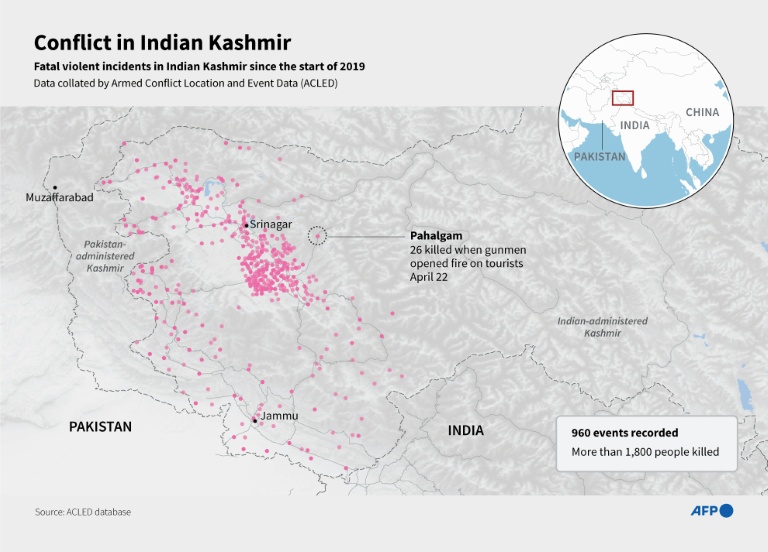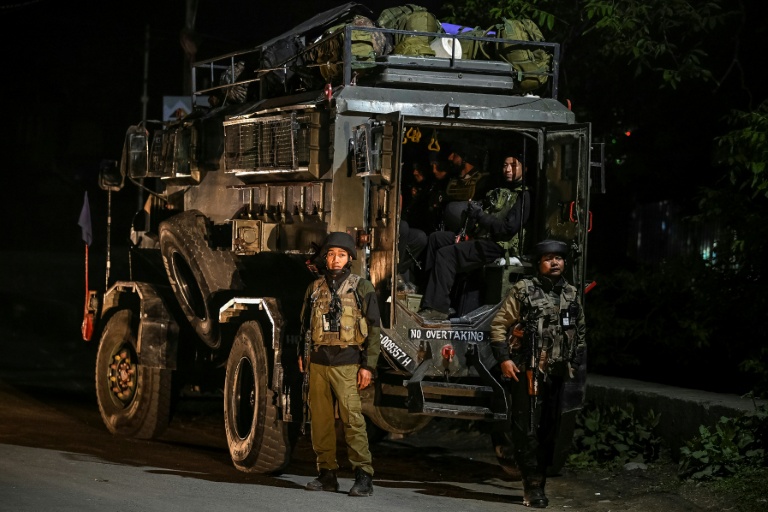India and Pakistan: A history of division and war

Nuclear-armed arch-rivals India and Pakistan have long accused each other of backing forces to destabilise them, especially in the contested Himalayan region of Kashmir that each controls parts of.
New Delhi regularly blames Islamabad for backing gunmen in Kashmir, who have fought an insurgency against Indian forces since 1989.
Islamabad denies it backs the insurgents, saying it only supports Muslim-majority Kashmir's struggle for self-determination.
The killing of 26 people in Indian-run Kashmir on Tuesday signalled a dramatic escalation in violence -- targeting civilians and the area's vital tourism industry -- and a shift from the common small-scale clashes between militants and security forces.

India on Wednesday took a raft of diplomatic measures against Islamabad, including shutting its key land border crossing and suspending a water-sharing treaty.
Pakistan then announced a meeting of its National Security Committee, summoned only in cases of external threat or major attack.
Here are key events in their troubled relationship.
- 1947: Partition and war -
On August 15, 1947, two hundred years of British rule come to an end, leading to the division of the subcontinent into predominantly Hindu India and Muslim-majority Pakistan.
The inadequately planned partition triggers violence resulting in potentially over a million deaths and displacement of 15 million individuals.
Kashmir's ruler hesitates about choosing between submitting to Indian or Pakistani authority.
However, following the quelling of the rebellion against his authority, Pakistan-supported insurgents launch assaults. In response, he requests assistance from India, which escalates into a full-scale conflict between the two nations.
In January 1949, a cease-fire line backed by the UN divided Kashmir into two parts along a 770-kilometer (478-mile) boundary called the Line of Control.
- 1965-71: Kashmir and Bangladesh wars -
Pakistan launches a second war in August 1965 when it invades Kashmir.
The hostilities conclude seven weeks later following a truce facilitated by the Soviet Union, resulting in numerous casualties on both sides with thousands of troops killed.
At the beginning of 1971, Pakistan sends troops to quell an emerging independence movement in what is currently Bangladesh, a region it has administered since 1947.
Approximately three million individuals perish during the nine-month conflict, with countless others escaping to India.
In 1971, India launches an invasion of Bangladesh, leading to Pakistan's defeat.
- 1989-90: Uprising in Kashmir
A rebellion erupts in Kashmir in 1989 when deep-seated complaints about Indian governance finally overflow.
Over the next year, Hindus and other minority groups leave the area due to targeted killings, attacks, and threats perpetrated by rebel combatants.
In the ensuing decades, tens of thousands of troops, insurgents, and ordinary people lose their lives in confrontations between law enforcement agencies and armed groups.
India charges Pakistan with financing the insurgents and assisting in their weapon training.
- 1998-99: Nuclear arms and the Kargil dispute -
In 1998, Pakistan carries out its initial publicly acknowledged nuclear weapon tests, shortly after India did so for the first time in 1974.
Militants supported by Pakistan entered Indian-controlled Kashmir in 1999, capturing military outposts in the frigid Kargil mountain region.
Raja Mohammad Zafarul Haq, a prominent figure within Pakistan's governing party, asserts that his nation will not hold back from employing nuclear weapons to safeguard its security whenever needed.
Pakistan caves in under intense pressure from Washington, which was spurred into action by intelligence indicating that Islamabad had moved portions of its nuclear weapons closer to the combat zone.
At that time, Pakistan's Prime Minister Nawaz Sharif attributes the outbreak of the conflict, which resulted in at least 1,000 deaths within a span of ten weeks, to Army Chief Pervez Musharraf’s actions without informing or seeking his consent. Months afterward, Musharraf leads a coup that removes Sharif from power.
- 2008-Present: The Mumbai Attacks and Modi
In 2008, Islamist militants assaulted Mumbai's financial center, resulting in the deaths of 166 individuals.
India accuses Pakistan's intelligence agency of being behind the attack and halts peace negotiations. Although contacts restart in 2011, the scenario remains disrupted by intermittent clashes.
In 2015, Indian Prime Minister Narendra Modi unexpectedly visits Pakistan, yet this easing of tensions doesn’t last long.
In 2019, a suicide bombing claims the lives of 41 Indian paramilitary personnel in Kashmir, leading Prime Minister Modi to authorize air strikes within Pakistani territory.
The tense confrontation between the two countries is quickly resolved, and Modi gets re-elected several months afterward, partially due to a surge of nationalist sentiment fueled by the military reaction.
Subsequently, Modi's administration revokes Kashmir's limited self-governance, a swift move that was followed by widespread detentions and a prolonged period of internet shutdowns and restricted communication.
In 2021, both countries restate their commitment to a 2003 cease-fire agreement; however, Pakistan maintains that peace negotiations may restart solely if India restores Kashmir’s autonomy as it was prior to 2019.
bur-sai/pjm/fox
Post a Comment for "India and Pakistan: A history of division and war"
Post a Comment